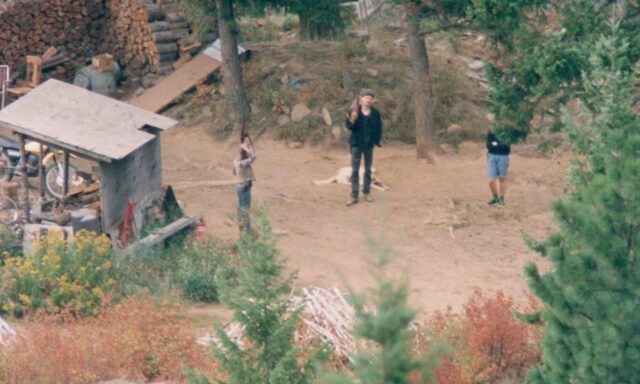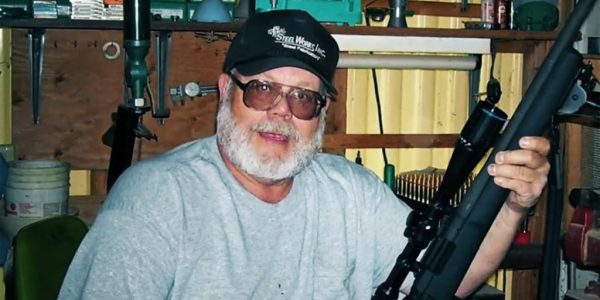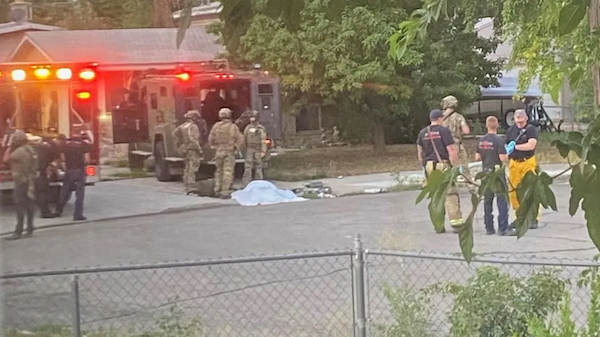
A surveillance photo of the Weavers with guns on the property in Ruby Ridge, 1992. Photograph: PBS
It’s been 31 years since the beginning of the FBI’s murderous siege on the home of the Weaver family. The deadly incident prompted enough outrage to spur Congressional hearings, protests from across the political spectrum, several dramatized TV portrayals and a promise from the FBI and Department of Justice that they would revise the reckless tactics used at Ruby Ridge to avoid future tragedies (this was six months before the Waco massacre).
Fast forward to 2023, and the only difference in relation to federal law enforcement behavior is the disappearance of journalists and politicians willing to demand accountability from the FBI.
As Republicans and Democrats waste time and political capital focusing on how the FBI treats Donald Trump or Hunter Biden, four men in the last three weeks have been shot to death by the FBI, three of them in questionable pre-dawn raids. Two of the men were white and right-wing, one was an Arab, and another was a black suspected for a string of robberies.
In a typical FBI related raid leading up to a shooting, federal agents make painstaking efforts to destroy any visible cameras on a targeted property, seldom wear body cameras, and refuse to inform family members why they felt they had to shoot their loved one or what they were suspected of. In some cases, the FBI will even refuse to confirm their involvement in a killing. In these controversial shoots, the Bureau has the laughable ability to investigate itself, which predictably, means that they rule every killing as justified. The FBI then cordons off the scene and bans the family from entering their own residence for days as staff is dispatched to collect evidence, providing them ample opportunity to tamper with or eliminate any evidence of malfeasance or error.
In virtually every case, an agent who shoots a suspect in a contentious encounter is granted the informal right to forever remain anonymous by both the media and government officials — a perk not extended to local police officers in similar circumstances. If public outrage begins to grow, unrelated videos and information intended to characterize the person who was shot as a dangerous menace suddenly leaks to the press even as the FBI publicly keeps its lips sealed. The way these incidents unfold is akin to how death squads or assassins operate rather than a legitimate law enforcement agency subject to civilian oversight.
 In the most controversial of the recent shootings, that of a severely disabled 75-year-old Vietnam Veteran and National Rifle Association member in Utah named Craig Robertson, federal agents have asserted that the beloved church-going man with no notable criminal record who served as sole caretaker for his blind son was a dangerous white domestic terrorist who, upon being informed that he was under arrest, pointed his .357 Magnum at agents during an early morning raid.
In the most controversial of the recent shootings, that of a severely disabled 75-year-old Vietnam Veteran and National Rifle Association member in Utah named Craig Robertson, federal agents have asserted that the beloved church-going man with no notable criminal record who served as sole caretaker for his blind son was a dangerous white domestic terrorist who, upon being informed that he was under arrest, pointed his .357 Magnum at agents during an early morning raid.
Robertson was put under investigation in April for a series of threats made on his Truth Social account against Democratic politicians. He was obviously not physically capable of executing his threats, and despite being known to always answer the door armed, was approached by FBI agents and questioned about his threats prior to the raid on his home. He told the agents who arrived at his residence to question him that he had no plans to harm anyone and to come back with a warrant. The agents left without incident.
Days later, the FBI decided to mobilize their SWAT team to serve their warrant on the man in his humble Provo residence, using his collection of legally owned firearms and enthusiasm for the 2nd Amendment as justification for why a Navy SEALs type breach was necessary to apprehend the immobile senior citizen.
Video footage taken by a neighbor as the assault began shows federal agents tossing flash bombs and wrecking Robertson’s home in the lead up to the shooting. Images from the aftermath capture Robertson bleeding to death under a blanket on the street like an animal as agents casually chat over his body.
 What is missing from the equation is what happened in between. We will never know if the claim that Robertson, a man described by all who knew him as being incapable of hurting a fly, actually did point his firearm at the arresting agents because they don’t wear body cameras.
What is missing from the equation is what happened in between. We will never know if the claim that Robertson, a man described by all who knew him as being incapable of hurting a fly, actually did point his firearm at the arresting agents because they don’t wear body cameras.
Local police departments scrutinized in controversial shootings regularly host press conferences where they publicly release an officer’s body camera footage of the exchange in question, but despite a 2022 White House Executive Order instructing FBI agents to visually document their activities while engaging in arrests and search warrants, federal agents have decided to simply ignore the new regulation. Compliance remains low.
Provo Police Department body camera video from a 2018 encounter with Robertson shows that he typically displayed his firearms when answering the door as a form of 2nd Amendment activism. In this encounter with local cops, he was not charged with any crime as Utah law protects the right of citizens to carry their guns, including in the presence of police officers. Even if Robertson had firearms on his person at the time his home was being besieged, unless he pointed one at arresting agents, the legality of killing him would be at least dubious. Judging from his well-documented pattern of behavior, as well as the FBI’s own pattern of systematically lying about almost everything, there is no reason to believe the FBI and Department of Justice when they say Robertson pointed his gun at their agents.
Several other open questions remain. Generally, threats to the president are handled by the Secret Service, who will investigate the offending individual and, if there is no sign of a plan to make good on the threat, warn the person to stop and occasionally park a car in front of their homes if the politician on the receiving end of their threats is in town. This was the norm when Donald Trump was elected in 2016 and a wave of violent threats aimed at his person and family engulfed social media and kept the Secret Service busy. Some former FBI agents have suggested that the Department of Justice possibly decided to internally mark Robertson as a white domestic terrorist in order to fill politically expedient arrest quotas, which takes the investigative duty out of the hands of the Secret Service and can be used to rationalize the disproportionate response federal agents have in recent years gotten into the habit of deploying against political opponents.
In other recent shootings, which have gone under the radar, we know even less about the circumstances that led to people being killed.
In Henderson, Tennessee, a similar pre-dawn FBI paramilitary-style raid was conducted on the residence of another disabled veteran, Theodore Deschler, whose social media page had several references to right-wing ideas. According to Deschler’s mother, who was yanked out of the house and thrown into the back of a car without an explanation after answering the door on the day of the killing, the FBI began bombarding the home with tear gas and stun grenades, breaking all the windows, and suddenly, began shooting the property up when a startled Deschler emerged. Deschler’s mother said Theodore did not have access to any guns and it would’ve been physically impossible for an agent to have seen if he was armed due to several tall obstructions blocking their view as they opened fire. It is unlikely Deschler had any weapon in his hand, according to his mother, due to the presence of two bloody handprints he left on the wall after being shot.
The FBI has refused to state what the warrant they were supposed to serve Deschler was related to and his grieving family has had no choice but to search through their ruined house for clues. As in Robertson’s case, no body camera footage appears to exist. Deschler was previously arrested for a stabbing in Tennessee in May, but unless there was a racial or “hate crime” (white men committing “hate crimes” has become a favorite FBI moral panic in recent years) angle, this should’ve been a local law enforcement issue and did not warrant the type of drastic escalation the FBI typically brings with it when it decides to get involved.
A day before the Robertson shooting, the FBI executed another dramatic assault, this time conducted on the home of Ahmad Nassar.
The modus operandi was remarkably similar to what happened in Henderson. The FBI was trying to arrest a drug addicted, mentally disabled but largely harmless man who law enforcement previously placed in a psychiatric hospital when they found him babbling in a public park waving an ISIS flag. As with Deschler, the FBI refuses to state what Nassar did to warrant such a response and the family publicly stated that there were no firearms in the house for Nassar to access.
 Seeing how federal agents have recently revived their practice of entrapping teenage boys in “ISIS-inspired plots,” the case may be “terror” related and possibly an attempt to establish a nebulous ISIS link in the interest of justifying the FBI’s bloated and increasingly controversial counter-terrorism budget.
Seeing how federal agents have recently revived their practice of entrapping teenage boys in “ISIS-inspired plots,” the case may be “terror” related and possibly an attempt to establish a nebulous ISIS link in the interest of justifying the FBI’s bloated and increasingly controversial counter-terrorism budget.
While the vast majority of FBI abuses come from its famously corrupt and politicized “terrorism” and counter-intelligence divisions, there has also been one recent shooting at the hands of its street crime wing.
On August 5th, federal agents shot a 22-year-old black man, Tahiem Weeks-Cook, while serving warrants in Philadelphia.
The FBI, which regularly bullies, harasses and arrests small town white police officers for violations as petty as exchanging “racist” text messages, has adamantly refused to provide any details related to their killing of Weeks-Cook. National media outlets, who generally can’t resist using stories of law enforcement shooting a black man to whip up anti-white hate, have largely ignored the story, though some outlets have published records showing the suspect was wanted for a string of robberies.

Randy Weaver
Just like FBI sniper Lon Horiuchi was never prosecuted for his role in killing Vicki Weaver at Ruby Ridge or being one of the shooters that triggered the Waco standoff, there is little chance that the aforementioned killings will ever be examined by independent investigators, much less lead to accountability if agents were to be found to have engaged in criminal conduct during these botched arrests.
In recent years, the FBI has emerged as the greatest threat to the civil liberties and well-being of our citizens, especially those who use their First or Second Amendment rights. Few in Congress appear willing to provide serious oversight of the FBI. The Bureau is highly insular and ideological, and agents behave in a way that suggests they see ordinary Americans as their enemy.
For this reason, presidential candidates releasing plans to abolish the FBI are surging in the polls. Some federal agents, who are on the frontline enforcing a status quo that has lost public confidence, have reported that they feel uneasy while operating in middle America. This fear and paranoia is causing them to violate their own operation’s guidebook calling for the least intrusive measures possible, and instead are choosing to go in guns blazing.
Without an overwhelming political response and attorneys ready to fight for transparency in court, the shadowy killings by America’s secret police will continue.
Written by Eric Striker for The Unz Review ~ August 23, 2023

Let’s see, how does that saying go again? Oh yeah….
“If someone tries to kill you, kill them right back.”
Folks don’t believe me when I tell them I will never be taken alive by scumbag tyrant goon squads. Boy, won’t they be surprised when they watch the evening news.